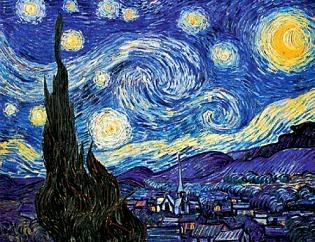The Starry Night

The Starry Night is probably Vincent Van Gogh's most famous and most recognizable masterpiece. It was painted in 1889, a year or so before he died in 1890 at the age of 37, from a self-inflicted gunshot wound.
Van Gogh suffered from manic-depression, a form of bipolar disorder. During a fit of mental instability he attempted kill associate Paul Gaughin with a razor, and the same night he cut off the lower half of his own left ear, wrapped it in cloth, then went to a brothel and handed it to a prostitute named Rachel. He later had himself committed to several asylums in the hope of being cured. It was this mental illness which ultimately led to his own self destruction.
The Starry Night is a livid painting, highly stylized and characterized by swirling yellows and planets seemingly spinning out of control. Even the hills surrounding the town seem to be rolling furiously, yet all the depicted motion has an uncanny soothing effect.
There are some who suggested that Van Gogh's The Starry Night to some extent is a actually a true-to-life depiction of the night sky, but astronomers have not been able to confirm this. This really isn't surprising since Van Gogh composed this work from his own imagination, which he himself admitted and described in a letter to his brother.
The Starry Night is a fitting tribute to a man's insanity, and at the same time his genius.
For Naoms.
Fellow blogger Aileen who shares a fascination with this work also posted something about this painting some time ago. Read her thoughts on it here.
Addendum:
It turns out Teacher Sol is also an admirer of Van Gogh's work. Check out the Van Gogh tribute she has on her other blog here.
Comments